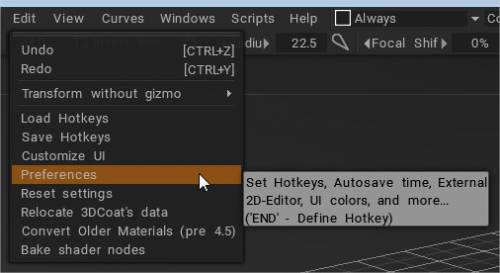
Bu Panel, 3DCoat kişiselleştirmenize izin veren ayrıntılı bir ayarlar iletişim kutusu açar. Size mevcut kategoriler ve seçenekler hakkında genel bir bakış sunacağız.
Genel sekmesi
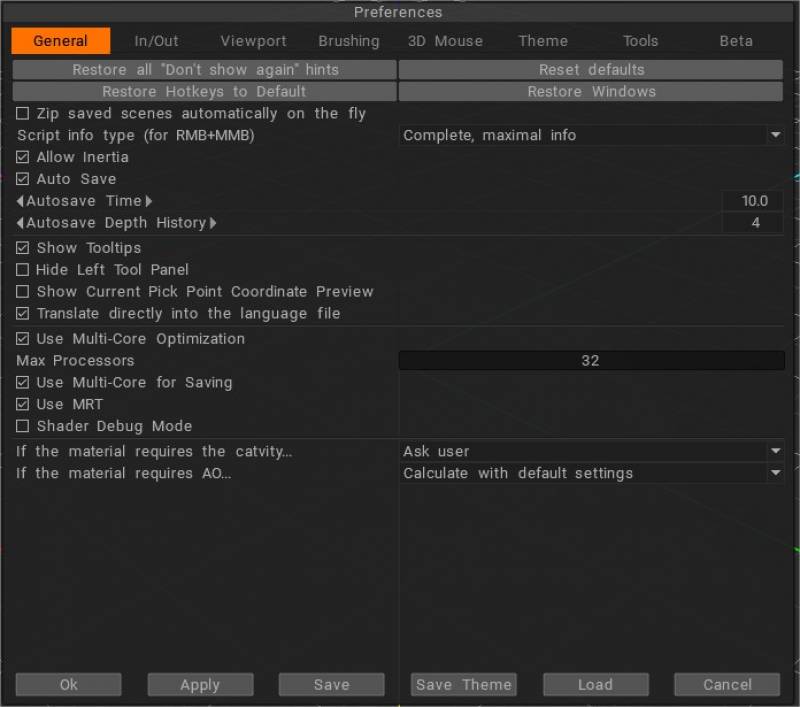
Bu iletişim kutusunun üst kısmında, 3DCoat “fabrika” varsayılan ayarlarına döndürmenizi sağlayan dört sabit seçenek vardır:
Tüm “Bir daha gösterme” ipuçlarını geri yükleyin: Görüntülenmesini istediğiniz türde ipuçlarını ve bunların nerede görüntülenmesini istediğinizi belirtin.
Kısayol Tuşlarını Sıfırla: Tüm ayarları varsayılan durumuna geri yükleyin.
Kısayol Tuşlarını Varsayılana Geri Yükle: Kısayol tuşlarını birlikte dağıtıldıkları duruma sıfırlayın.
Windows’u ve konumlarını geri yükleyin: Tüm pencereleri varsayılan konumlarına ve boyutlarına geri yükleyin.
Zip kaydedilen sahneler:
Atalete izin ver : Örneğin, kaydırma tekerleğinin bir web tarayıcısında çalıştığı şekilde araçta ve diyalog kaydırmada hız kazanmak için kaydırma tekerleğinizi kullanmanıza izin verir.
Otomatik Kaydet : Zaman aralıklarını ve derinlik geçmişini ayarlamak için otomatik kaydetmeyi açın/kapatın ve otomatik kaydetme süresini ayarlayın. Otomatik kaydetme dosyası, Kullanıcı Verileri klasöründe bulunan autosave.3b adına sahiptir.
Otomatik Kaydetme Derinliği Geçmişi: Sıralı olarak saklanacak otomatik kaydetme dosyalarının miktarı.
Araç İpuçlarını Göster: Fare imlecinizin yakınında açılan araç ipuçlarını göstermenizi veya gizlemenizi sağlar .
Genişletilmiş Araç İpuçlarını Göster (3B Görünüm Penceresinin Altı) .
Sol Araç Panelini Gizle: “Boşluk” menüsünü kullanmayı tercih ederseniz sol araç panellerini gizleyebilirsiniz.
Geçerli Seçim Noktası Koordinat Önizlemesini Göster .
Çok Çekirdekli Optimizasyonu Kullanın: Tercihlerinizi sistem donanımınıza göre ayarlayın.
Maksimum İşlemci: 3DCoat ile kullanılacak İşlemci sayısı.
Kaydetmek için Çok Çekirdekli kullanın .
MRT kullanın: Gerçek zamanlı normal map güncellemelerini hızlandırmak için birden çok oluşturma hedefi kullanın.
Gölgelendirici Hata Ayıklama Modu: Gölgelendirici hata ayıklama modu, gölgelendiriciler derlenirken hataları görmenizi sağlar. Varsayılan olarak kapalı.
AO/Eğrilik katmanları için Tercihlerdeki yeni seçenekler: Varsayılan değerleri hesapla/iletişim kutusuyla sor/hesabı atla.
Import ve Export
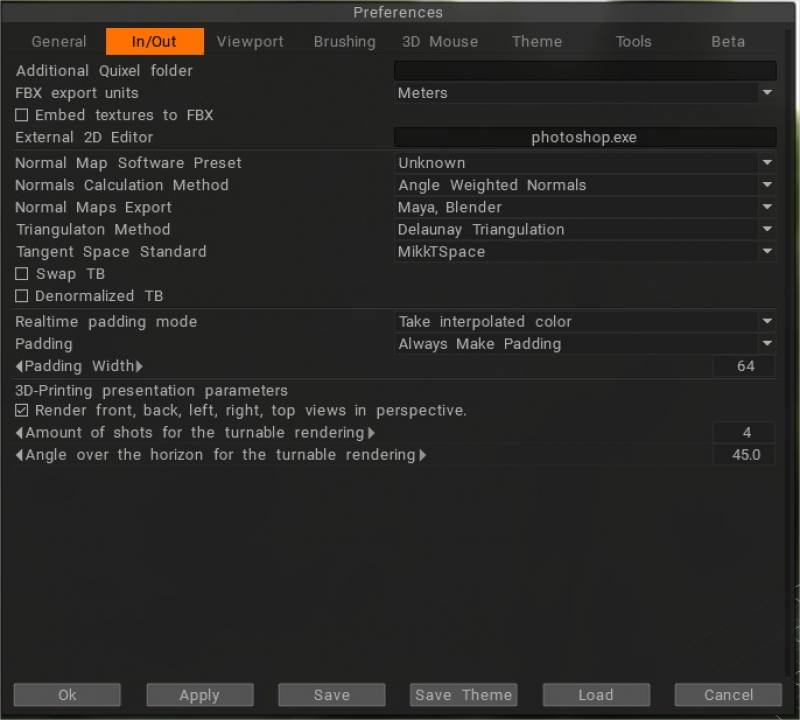
– Mega tarama desteği iyileştirmesi: Yeni seçenek Düzenle > Tercihler > G/Ç > Ek Quixel klasörü.
Başlangıçta, “3DCoat”, zip arşivleri ve önceden çıkarılmış klasörler olarak yeni Quixel malzemeleri için “İndirilenler” ve “Ek Quixel klasörü”nü kontrol eder.
FBX export birimleri: FBX’te anlamı olan birimler. Metre, ölçek 1:100, Santimetre 1:1, Milimetre – 10:1 anlamına gelir. Bu, yalnızca FBX export için geçerlidir.
Dokuları FBX’e göm: FBX’i export aktardığınızda, dokular doğrudan FBX dosyasına gömülür.
Harici 2B Düzenleyici: Bu yol, 2B görüntüleri düzenlemek için hangi harici ‘Paint’ uygulamasını (örn. Photoshop) kullanmak istediğinizi belirtmek için kullanılacaktır. Bu düzenleyici PSD dosyalarını düzenleyebilmelidir, bu nedenle genellikle Adobe Photoshop. Bu düzenleyicinin adı “Düzenle” – “Katmanları Ext ile Senkronize Et. Ext.’deki Tüm Katmanları Düzenleyin/Düzenleyin. Ext.’de Editör/Projeksiyonları Düzenle Editör”.
Normal Harita Yazılımı Ön Ayarı: Normal Haritalarınızın 3. taraf uygulamalarında dahili ve harici olarak nasıl ele alınmasını istediğinizi tam olarak belirlemek için bu seçenekler dizisini kullanın. Her yazılım için önerilen parametrelerin bir listesi vardır.
Normaller Hesaplama Yöntemi: Boyama için ağ normallerinin nasıl hesaplanacağını seçin.
Normal haritaları export: Normal haritaları dışa aktarma standardını seçin: 3D-Max veya Maya.
Nirengi Yöntemi: Nirengi yöntemi, normal haritaların uyumluluğu açısından önemlidir. Nirengi yöntemi modelleme yazılımınıza uymuyorsa ve normal haritalar bake – dörtlülerde çapraz benzeri eserler görünebilir.
Teğet Alan Standardı: Teğet alan, normal haritaları doğru bir şekilde oluşturmak için önemlidir. Yanlış teğet alanı kullanırsanız, modelleme yazılımınızda pişmiş modelde dikişler görünür olacaktır. Bu nedenle, 3DCoat dışa aktardıktan sonra, modelleme yazılımınız ile uyumlu olan yöntemi seçmeniz gerekir. Fark, organik modellerde çok belirgin değildir ancak esas olarak sert yüzeyli modellerde pişirmeyi etkileyebilir.
TB’yi Değiştir: Normal yönü ters çevirin.
Denormalized TB: Denormalized Texture Baking, haritadaki her normalin uzunluğunu 1’e sıfırlamak anlamına gelir.
Gerçek Zamanlı Dolgu modu: Dolgu için birkaç yöntem vardır.
– İlki, karşı adadaki pikseller arasında rengi doğrusal olarak enterpolasyon yapar.
– İkincisi, karşı adadan en yakın pikseli alır.
– Üçüncüsü, naif, mevcut adadan en yakın pikseli alır.
Dolgu: Dokuları export , doku kümelerinin etrafında bir kenarlığa (dolgu) ihtiyacınız olup olmadığı sorulacaktır. Bu seçenek, soruyu otomatik olarak yanıtlamanızı sağlar.
Dolgu genişliği: Dolgu genişliği, doku dışa aktarılırken kullanılır.
3D Baskı sunum parametreleri
Perspektifte ön, arka, sol, sağ ve üst görünümleri işleyin .
Pikap işleme için çekim miktarı.
Pikap işleme için ufukta açı.
görünüm alanı
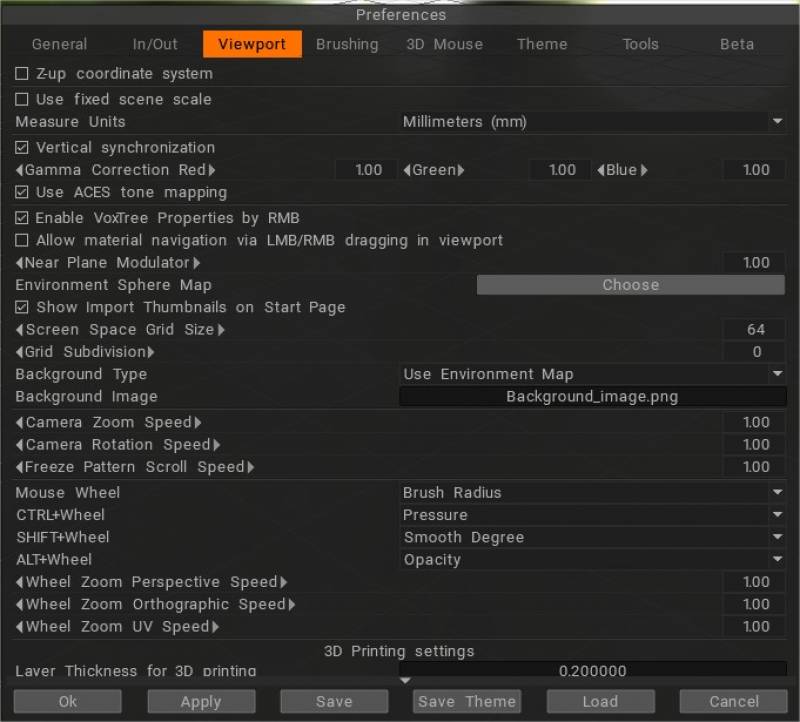
Z-up koordinat sistemi: Rhino, 3DS-Max ve Z ekseni yukarı olan diğer uygulamalarla uyumluluk için Z-up tabanlı koordinat sistemi.
Sabit Sahne Ölçeği Kullan: Sabit bir sahne ölçeği kullanırsanız, önceden kaydedilen sahneler dışında nesne her zaman bu ölçekle açılır. Bu, nesnelerin çok büyük veya çok küçük olduğu durumlarda sorunlu olabilir. Ölçeklendirilmiş nesne boyutunun 10-300 aralığında tutulması önerilir.
Sabit Sahne Ölçeği: Nesneleri import için sahne ölçeği.
Ölçü Birimleri: Yalnızca birimler için görsel işaretlerdir. Birimlere bağlı olarak gerçek ölçeklendirme yapılmaz.
Dikey senkronizasyon :
Gama Düzeltmesi: Kırmızı/Yeşil/Mavi.
ACES ton eşlemeyi kullanın : ACES ton mapping kullanın.
RMB ile VoxTree Özelliklerini Etkinleştir : Şekillendirme odasında RMB özellikleri penceresini etkinleştirin veya devre dışı bırakın. Pencere, Windows→Açılır Pencereler→Tetikleme birimi özellikleri penceresinde bir kısayol tuşu atanarak da devre dışı bırakılabilir.
Görünüm alanında LMB/RMB sürükleme yoluyla malzeme gezinmesine izin ver: Görünüm alanında LMB/RMB sürükleme yoluyla malzeme gezinmesine izin ver.
Yakın düzlem modülatörü: Viewport Kamerasının bir nesneye ne kadar yaklaşabileceğini ayarlamanıza izin verir. Yüzeye daha yakın hareket edebilmek için uçağa yakın bir kamerayı ayarlar.
Ortam küre haritası: Herhangi bir çevresel etkinin işlenmesinde hangi küresel görüntünün kullanılacağını belirtin.
Başlangıç sayfasında import küçük resimlerini göster.
Ekran Alanı Izgara Boyutu: Izgara boyutunu piksel cinsinden ayarlayın.
Grid Subdivision: Bu değer, ekran ızgarasındaki alt bölümlerin sayısını temsil eder. Hiçbiri için sıfır kullanın.
Arka Plan Türü: Sahne arka plan stili.
Arka Plan Resmi: Arka plan olarak kullanılacak görüntü.
Kamera Yakınlaştırma Hızı: Kamera Yakınlaştırma Hızını belirler.
Kamera Dönüş Hızı: Kamera Dönüş Hızını belirler.
Kalıbı dondur Kaydırma Hızı: Kalıbı dondur kaydırma hızı. Dondur menüsündeki donmuş alanları belirtmek için kullanılan deseni değiştirin.
Fare Tekerleği: Fare tekerleği ile hangi parametrenin değiştirileceğini seçin.
Orta fare düğmesiyle kaydırma yapabilmek için “Fare Tekerleği”ni “Yakınlaştır” olarak ayarlayın.
“Wheel Zoom… Speed” yazan alttaki 3 ayarın 1 olarak ayarlandığından emin olun. Zoom istediğiniz yöne gitmiyorsa -1 olarak değiştirin.
Ctrl+Wheel: Ctrl+fare tekerleği ile hangi parametrenin değiştirileceğini seçin.
Shift+Wheel: Shift+ fare tekerleği ile hangi parametrenin değiştirileceğini seçin.
Alt+Wheel: Alt+fare tekerleği ile hangi parametrenin değiştirileceğini seçin.
Tekerlek Yakınlaştırma Perspektif Hızı: Tekerlek Yakınlaştırma Perspektif Hızını belirler.
Tekerlek Yakınlaştırma Ortografik Hızı: Tekerlek Yakınlaştırma Ortografik Hızını belirler.
Wheel Zoom UV Speed: Wheel Zoom UV Hızını belirler.
3B Yazdırma ayarları
3B yazdırma için Katman Kalınlığı: 3B yazdırma export için katman kalınlığı.
Yapı Boyutu: X,Y,Z’de.
fırçalama
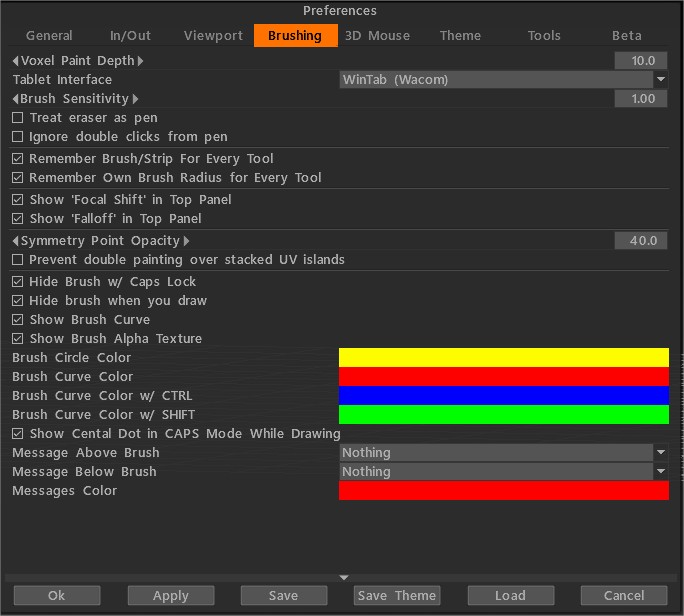
Voxel boya derinliği: Voksel resminin derinliği. Büyük bir renk penetrasyon derinliğine dikkat edin, artefaktlara (nesnenin başka bir tarafına nüfuz etme, gürültülü yüzeyler üzerinde gürültülü renkli noktalar) neden olabilir. Bu nedenle, gürültülü yüzeyler için düşük boya derinliği öneriyoruz. Dikkat edin, daha büyük derinlik daha yavaş performansa yol açar.
Tablet Arayüzü: Wintab veya Tablet PC’yi seçmenize izin verir. (Win tablet özellikleri altındaki “Windows Ink Kullan” onay kutusunun işaretini kaldırın.)
Brush Hassasiyeti : Dijital kalem kullanıyorsanız Kalem hassasiyetini ayarlayın.
Silgiye bir kalem gibi davranın .
Kalemden çift tıklamayı yoksay: kalemle çift dokunuşla vuruş başlatmaya izin verir.
Her Alet İçin Brush/Şeridi Hatırla: 3DCoat bu Brush her kullandığınızda önceki ayarları hatırlamasını isteyip istemediğinizi belirtin.
Her Alet İçin Kendi Brush Yarıçapını Hatırla: Brush her kullandığınızda 3DCoat önceki ayarları hatırlamasını isteyip istemediğinizi belirtin.
Üst Panel Görünümü Brush Tercihleri: Ekran alanınız kısıtlıysa veya Brush Düşüşünü veya Odak Kaymasını sık sık kullanmıyorsanız, üst panelde ‘Odak kayması’ ve Düşüş kaydırıcısını gizlemeyi seçebilirsiniz.
- Üst panelde Odak kaydırmayı göster: Üst panelde “Odak kaydırma” kaydırıcısını gösterin.
- Falloff’u üst panelde göster: Üst panelde “Falloff” kaydırıcısını gösterin.
Simetri Noktası Opaklığı .
İstiflenmiş UV adaları üzerinde çift boyamayı önleyin: Bu seçenek, istiflenmiş veya aynalanmış UV adalarınız varsa önemlidir. Seçenek etkinleştirilirse, UV haritasındaki nokta vuruş başına yalnızca bir kez boyanabilir.
Yığılmış adaların birbirleriyle sınırı olmaması yararlıdır (örneğin, gövde – bir ada, kollar ve bacaklar – diğer aynalı adalar). Simetriyi ve bu seçeneği etkinleştirirseniz, kollar ve bacaklar iki kez boyanmaz.
Ancak aynalı adaların aralarında ortak bir sınırı varsa, bu seçeneğin etkinleştirilmesi, kenarın her iki yanında aynı piksel bulunduğundan ortak kenarların yakınında bozulmalara neden olur.
Brush Büyük Harf Kilidi ile Gizle: Bu seçenek işaretlenirse, fırça CAPS LOCK modunda sürekli olarak gizlenir; aksi halde sadece çizim sırasında gizlenecektir.
Vuruş Yaparken Brush Gizle: Bu seçenek işaretlenirse, çizim sırasında fırça gizlenir.
Brush Eğrisini Göster:
Brush Alfa Dokusunu Göster:
Brush Dairesi Rengi:
Brush Eğrisi Rengi:
CTRL ile Brush Eğrisi Rengi:
SHIFT ile Brush Eğrisi Rengi:
Çizim Sırasında Büyük Harf Modunda Merkezi Noktayı Göster:
Brush Üstü Mesaj:
Brush Altındaki Mesaj:
Mesaj Rengi: Fırçanın altındaki veya üstündeki mesajların rengi.
Kompakt arayüz: Kompakt/tam arayüz arasında geçiş yapın. SEKME kısayol tuşu.
3D Fare
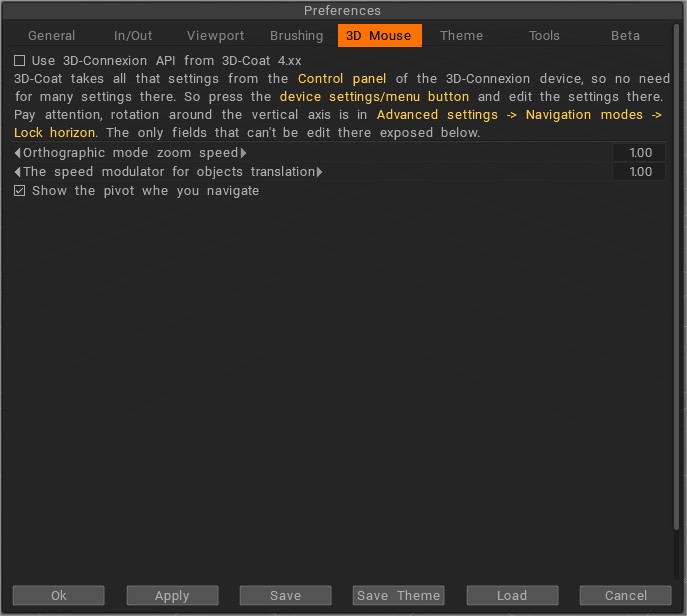
3DCoat, 3DConnexion’dan 3D Space Navigator’ı destekler. 3D farenizi kontrol etmek için tüm seçenekleri burada bulabilirsiniz. Bu cihazlardan birine sahipseniz, ihtiyacınız olan kesin kontrol türünü elde etmek için bu ayarları kullanın.
3DCoat, tüm bu ayarları 3D-Connexion cihazının Kontrol panelinden alır, bu nedenle orada çok fazla ayara gerek yoktur.
Bu yüzden cihaz ayarları/menü düğmesine basın ve ayarları orada düzenleyin. Dikkat edin, dikey eksen etrafında dönüş, Gelişmiş ayarlar → Navigasyon modları → Ufku kilitle seçeneğindedir.
Orada düzenlenemeyen tek alanlar aşağıda gösterilmiştir.
Ortografik mod yakınlaştırma hızı
Nesne çevirisi için hız modülatörü : 3B fare ile nesne işleme modu açıldığında çeviri için ek hız modülatörü.
3dconnexion Desteği : Bu video, bir 3dconnexion cihazının, özellikle de amiral gemisi sürümü olan SpaceMouse Enterprise’ın 3DCoat kullanılmasının faydalarını gösterir. Kullanıcının sorunsuz çalışırken aynı anda altı farklı eksende gezinmesini sağlar. Bu, kullanıcının durması, gezinmesi ve devam etmesi gerekmediği için üretkenliği iki katına çıkarır ve hepsi aynı çalışma eliyle sürekli çalışır.
Aynı zamanda, iş yükünü iki el arasında paylaştırarak iş elindeki tekrarlayan eylem stresini azaltır. Ayrıca, kullanıcının ellerini klavyesinden ve modeline odaklanmasını engeller.
3D 3D-Coat 4.xx’ten 3D-Connexion API kullanın: 3D-Connexion API’nin daha eski bir sürümünü kullanın. Tavsiye edilmez, çünkü bazı durumlarda kablosuz cihazlar (fare, kalem, klavye) kullanıyorsanız ek gecikmelere neden olabilir. Ancak yeni API işinize yaramazsa, lütfen daha eski bir API kullanın.
Tema

Klasörleri Düğme Olarak Göster
Maks. klasör listesindeki satır miktarı: Fırçalar, şablonlar, hazır ayarlar vb. öğe listeleri için kullanılan klasörler listesindeki maksimum satır miktarı.
Yazı Tipi Boyutu: Yazı tipi boyutunu seçin.
Yazı tipi tipi ve arayüz renkleri Rygaard tarafından nasıl özelleştirilir
Bu videoda 3DCoat yazı tipi tipini ve arayüz renklerini nasıl özelleştireceğinizi gösterecek.
Kaydırıcıları Gizle: Kaydırıcı çubuğunu gizleyin.
Açılır liste yerine sekmeleri kullanın: 3DCoat2023’te, V2021’den kutu tipi oda geçişi artık ortam ayarında V4 döneminde tanıdık sekme tipine çevrilebilir.
Kendi renk şemanızı kaydedin: Düğmeye basın, ardından renk şemasının adını girin, Windows > UI renk temasında görünecektir ve tema dosyası “Docs/ 3DCoat/UserPrefs/UI_Color_Themes/TheMeName.json” klasörüne yazılır. . Bu ada sahip tema varsa, üzerine yazılacaktır.
3B Düğme Rengi: Düğmeler için bir 3B stil kullanın.
Degrade Menü: Menüler ve arka planlar için bir degrade doku kullanın.
Ekran Renkleri: Temanızı kişiselleştirmek için renkleri değiştirin.
Tercihlerin bu bölümlerindeki tüm Arayüz Teması ve Düzeni seçenekleri, tüm arayüzün görünümünü ve düzenini tam olarak tasarlamanıza olanak tanır. İki kişi aynı şeyleri sevmez, bu nedenle bu ayarlar, 3DCoat “Görünüm ve Hisset” özelliğini tam olarak tercih ettiğiniz şekilde ayarlamanıza izin vermek için sağlanmıştır.
Kullanıcı arayüzü tamamen özelleştirilebilir. Varsayılan olarak, kurulum sırasında mevcut olan üç UI teması vardır.
Bunlar “Koyu”, “Gri” ve “Açık”tır.
Düzenle–>Tercihler–>Yükle’ye giderek bir kullanıcı arayüzünü değiştirebilirsiniz; “OptionsPresets” adlı bir klasöre yönlendirileceksiniz, içinde her biri bir temaya karşılık gelen 3 .xml dosyası vardır, temaları yüklemek için sadece bir .xml dosyası seçin ve Aç’ı tıklayın.
Kullanıcı arabiriminin daha birçok bölümünü düzenleyebilir, kendi Kullanıcı Arabirimi temanızı oluşturabilir ve bunu bir .xml dosyası olarak kaydedebilirsiniz.
Sadece Düzenle → Tercihler’e gidin.
Burada metnin rengini, arayüz arka planını, başlığı, düğmeleri, ızgarayı, arka planı vb. özelleştirebilirsiniz. Ayrıca 3B düğme stilini ve Degrade menülerini açıp kapatabilirsiniz.
Sonuçta, bunlar yapılır, .xml dosyasını kaydedin ve tüm kullanıcı arayüzü ve kısayol tuşları ile diğer özelleştirilmiş bilgiler dosyada saklanır.
İstediğiniz zaman yükleyebilir veya arkadaşlarınızla paylaşabilirsiniz. Tercihler panelinde Kaydet düğmesine basmanız yeterlidir.
Araçların simgelerini kendiniz bile değiştirebilirsiniz, 3DCoat kurulum klasörüne gidin, texturesicons yolunda simgelerin kaynak PSD dosyalarını bulacaksınız, bunlar “baseicons.psd” ve “SmallIcons. psd”; PSD dosyasını Photoshop açın ve kendi simgelerinizi çizin.
Bittiğinde, bunları DDS formatında kaydedin, adı koruyun ve orijinal “baseicons.dds” ve “SmallIcons.dds” ile değiştirin.
3DCoat bir sonraki başlatışınızda, yeni simgeleri yükleyecektir.
Kenarlıklar (Yalnızca 4.9.# sürümü için kullanılabilir)
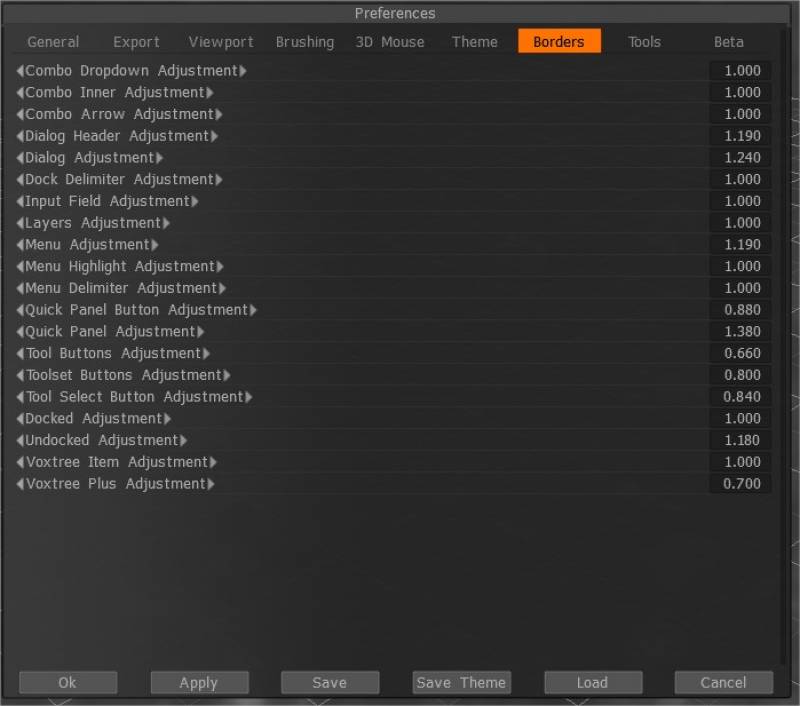
Panellerin, Kontrollerin ve Windows’un Kontrast arka plan rengini değiştirin.
Aletler
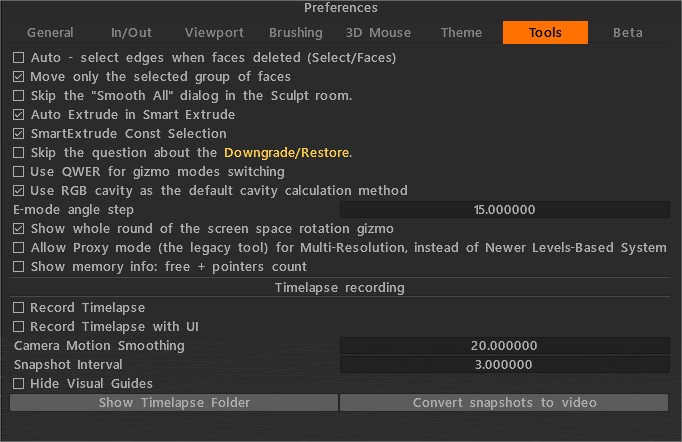
Yüzler silindiğinde kenarları otomatik seç (Seç/Yüzler): Seçilen yüzleri sildiğinizde sınırlayıcı kenarlar seçilecektir. Kenar seçimine ihtiyacınız yoksa kapatın.
Yalnızca seçili yüz grubunu taşıyın.
Şekillendirme odasında “Tümünü Düzgünleştir” iletişim kutusunu atlayın: Bu seçenek AÇIK ise, “Tümünü Düzgünleştir” iletişim kutusu görünmez. Yumuşatma yalnızca bir kez gerçekleştirilecektir.
Akıllı Ekstrüzyonda Otomatik Ekstrüzyon: Yeni Seçimden sonra otomatik taahhüdü genişletin.
SmartExtrude Const Seçimi: Seçim her zaman etkinleştirir.
Katman Düşürme/Geri Yükleme ile ilgili soruyu atlayın: VoxTree’den önbelleğe alma/önbelleği kaldırma seçeneğine tıkladığınızda, gerçekten buna ihtiyacınız olup olmadığı sorulacaktır. Bu seçenek açıksa, soru görünmez.
Gizmo modlarını değiştirmek için QWER kullanın: Gizmo modlarını değiştirmek için QWER’yi kullanarak açmak/kapatmak için kullanın.
Yalnızca seçili yüz grubunu taşıyın.
Varsayılan boşluk hesaplama yöntemi olarak RGB boşluğunu kullanın: Yeni RGB boşluğu, olası bir varsayılan hesaplama yöntemi olarak tanıtıldı. Bu durumda, çok aralıklı boşluk GPU’da hesaplanacak ve UI’de koşullar/akıllı malzemeler için ek kontrol görünecektir – “Boşluk genişliği”. Gerçek zamanlı PBR tekstüresi için çok önemli olan kavite genişliğinde/yumuşatmada gerçek zamanlı varyasyona izin verir.
Boşluk genişliği (RGB boşluğu kullanılarak), her katman için ayrı ayrı akıllı malzemeler için kullanılabilir. Her malzeme katmanının kendi boşluk genişliği ayarları vardır. Birkaç farklı “eskimiş” boya tabakası gibi “eskiyen” malzemeler için çok daha iyi efektler sağlar.
RGB boşluğu, çok aralıklı bir boşluk dokusudur, her kanal farklı bir boşluk ölçeğine karşılık gelir. B yerel boşluktur, G orta aralıktaki boşluktur ve R uzak aralıktaki boşluktur. Sırasıyla 1, 20 ve 100 yarıçaplı eğriliği RGB kanallarına dönüştürür.
Sahnede zaten eski kavite katmanınız varsa, bu özelliği kullanmak için onu silmeniz gerekir. Bu, doku/ağ üzerinde PBR boyaması için çok önemli bir özelliktir.
RGB boşluğu varsayılan olarak etkinse ve sahneyi eski tarz boşluk katmanıyla yüklüyorsanız, Coat sizi daha iyi kontrol elde etmek için boşluğu yeniden hesaplamanın daha iyi olduğu konusunda uyarır.
Ekran alanı döndürme aygıtının tüm turunu göster : Seç/Dönüştür aygıtı her zaman tam olarak kullanılamıyorsa (resimde görebileceğiniz gibi), okların aygıtla nerede etkileşimde bulunabileceğinizi ve ne zaman etkileşimde bulunamayacağınızı gösterdiği durumlarda bunu etkinleştirin.
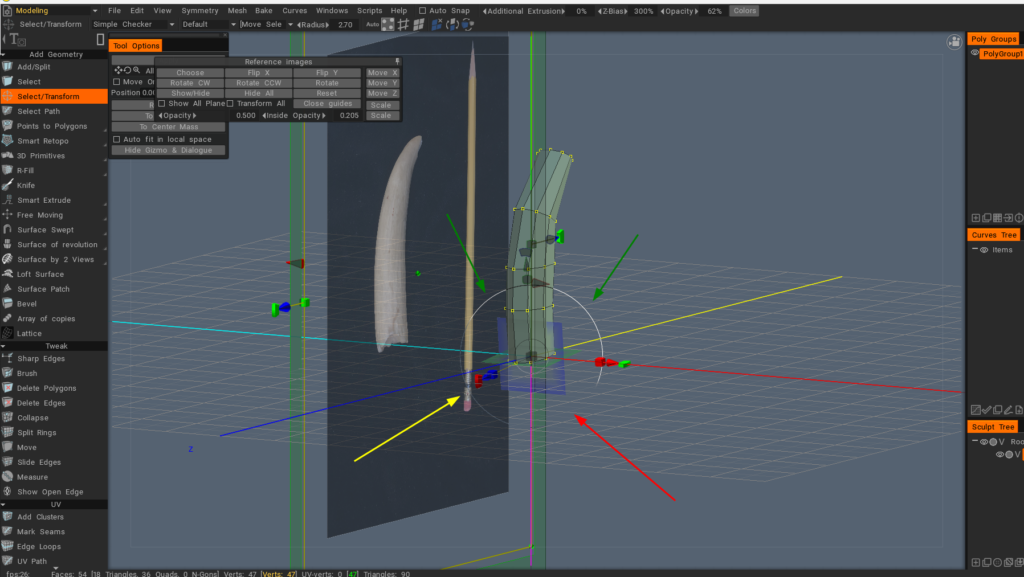
Proxy moduna izin ver (eski araç, bunun yerine çoklu çözünürlük kullanın): Proxy veya çoklu çözünürlüklü prosedürel nesneler arasındaki çelişkiyi engelleyen etkin değildir. Önbelleğe alma/proxy modunun eski yöntemi varsayılan olarak devre dışıdır.
Bellek bilgisini göster: boş + işaretçi sayısı: Bellek sızıntılarını araştırır ve bellek kullanımını araştırırsanız bu yardımcı olur.
Beta
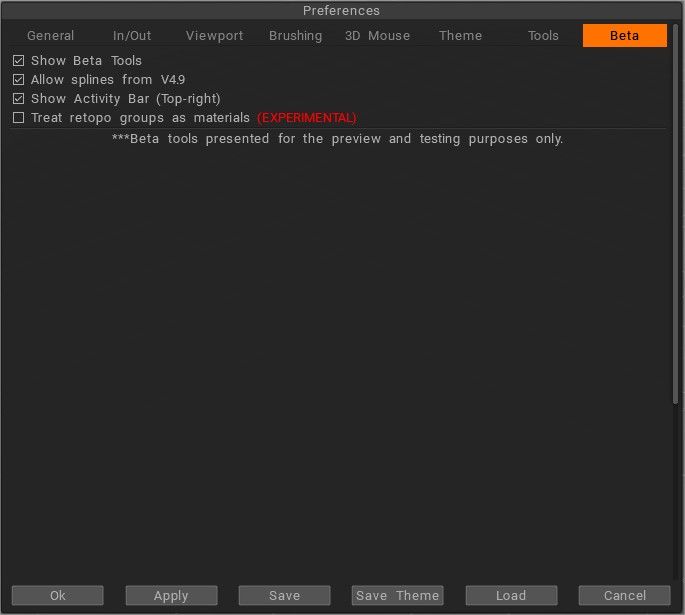
ShowBetaTools: 3DCoat hata düzeltmeleri ve diğer güncellemelerle sürekli olarak geliştiği için bu seçeneği her zaman etkinleştirmenizi öneririz. Beta araçlarını ve işlevlerini görmek ve kullanmak, yeni düzeltmeleri deneyimlemenize ve 3DCoat bir sonraki büyük sürümüne kadar mevcut olmayacak özelliklere gelişmiş bir bakış elde etmenize olanak tanır.
Hacimsel Painting İzin Ver :
V4.9’dan spline’lara izin ver: E-panelde spline’ların eski sürümünü etkinleştirin. Spline’ların yeni versiyonu da mevcut olacak.
Etkinlik çubuğunu göster (Sağ üst).
retopo gruplarını malzeme olarak ele alın DENEYSEL retopo gruplarını nesneler yerine malzeme olarak ele alın. Bu seçeneği kullanmanın riski size aittir, bu, 3D-Coat’ın olağan iş akışı değildir. Varsayılan olarak, retopo grupları nesneler olarak pişirilir.
Beta araçları yalnızca önizleme ve test amacıyla sunulur. 3DCoat 2022’nin önemli bir parçasını oluştururlar. 3DCoat 2022’nin yayınlanmasından sonra V4.9xx’te devre dışı bırakılabilirler.
 Türkçe
Türkçe  English
English Українська
Українська Español
Español Deutsch
Deutsch Français
Français 日本語
日本語 Русский
Русский 한국어
한국어 Polski
Polski 中文 (中国)
中文 (中国) Português
Português Italiano
Italiano Suomi
Suomi Svenska
Svenska 中文 (台灣)
中文 (台灣) Dansk
Dansk Slovenčina
Slovenčina Nederlands
Nederlands Magyar
Magyar ไทย
ไทย हिन्दी
हिन्दी Ελληνικά
Ελληνικά Tiếng Việt
Tiếng Việt Lietuviškai
Lietuviškai Latviešu valoda
Latviešu valoda Eesti
Eesti Čeština
Čeština Română
Română Norsk Bokmål
Norsk Bokmål